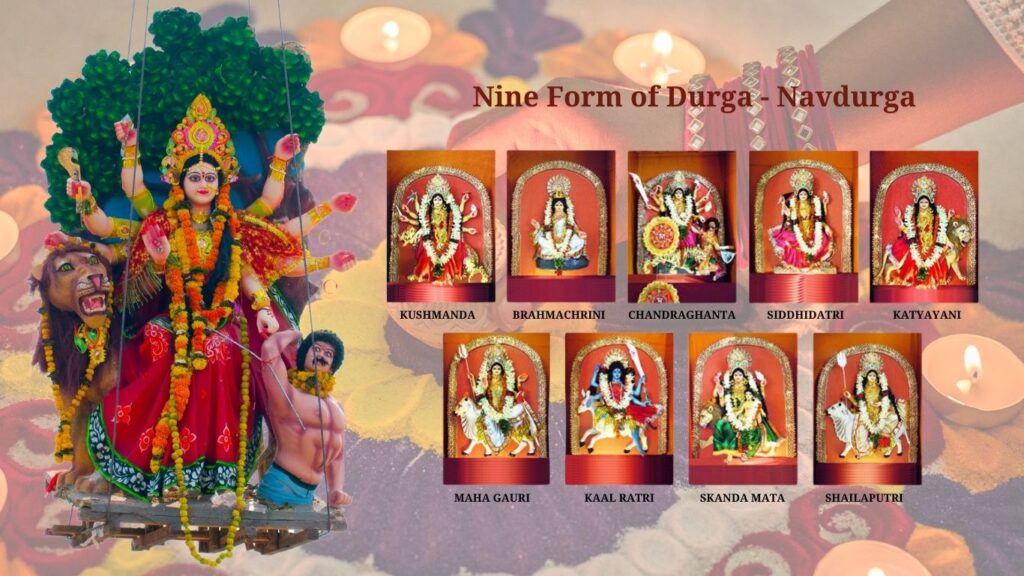
Mata Siddhidatri – The Goddess of Perfections
The ninth and final form of Goddess Durga is known as Siddhidatri. This divine incarnation embodies the completion of spiritual power and the attainment of Siddhis—mystical powers that enable the devotee to realize their highest potential.
Origin and Significance
In the beginning of the universe, Lord Rudra worshipped Adi-Parashakti for creation. It is believed that Adi-Parashakti, the supreme goddess of power, initially had no form. She manifested in the form of Siddhidatri from the left half of Lord Shiva, symbolizing the union of masculine and feminine energies. This remarkable birth granted Lord Shiva the title of Ardhanarishwar, signifying the inseparable nature of both energies.
Siddhidatri is revered as the bestower of all Siddhis. The eight Siddhis she grants are:
Anima – The ability to become as small as an atom.
Mahima – The power to become infinitely large.
Garima – The ability to become heavy at will.
Laghima – The power to become light.
Prapti – The ability to obtain anything desired.
Prakamya – The power to fulfill any wish.
Iishitva – The ability to control others.
Vashitva – The power of subjugation.
The significance of Siddhidatri is such that not only humans, but also Devas, Gandharvas, Asuras, Yakshas, and Siddhas worship her for spiritual progress and enlightenment.
Navratri Worship
Goddess Siddhidatri is worshipped on the ninth day of Navratri, marking the culmination of the festival and the attainment of spiritual completeness.
Governing Planet
Siddhidatri is believed to provide direction and energy to Ketu, a planet associated with spiritual enlightenment and liberation. Thus, she governs the energies of Ketu, further emphasizing her role as a guiding force in spiritual journeys.
Iconography
In her divine form, Siddhidatri rides a lion and is often depicted seated on a lotus flower (Kamal). She has four hands, each holding symbolic objects:
A Gada (mace) in one right hand, representing power.
A Chakra (discus) in the other right hand, signifying protection and the destruction of evil.
A lotus flower in one left hand, symbolizing purity and enlightenment.
A Shankh (conch shell) in the other left hand, representing the cosmic sound and the call to spiritual awakening.
Her serene and pleased demeanor exudes a sense of tranquility and grace, inviting her devotees to seek her blessings.
Worship and Prayers
Devotees chant the following mantra to honor Goddess Siddhidatri:
ॐ देवी सिद्धिदात्र्यै नमः॥
Om Devi Siddhidatryai Namah॥
Prarthana (prayer)
The Prarthana (prayer) dedicated to her is as follows:
सिद्ध गन्धर्व यक्षाद्यैरसुरैरमरैरपि।
सेव्यमाना सदा भूयात् सिद्धिदा सिद्धिदायिनी॥
Siddha Gandharva Yakshadyairasurairamarairapi।
Sevyamana Sada Bhuyat Siddhida Siddhidayini॥
This prayer seeks her blessings to bestow Siddhis upon devotees, allowing them to overcome obstacles and fulfill their desires.
Stuti (hymn)
The Stuti (hymn) recited in her praise is:
या देवी सर्वभूतेषु माँ सिद्धिदात्री रूपेण संस्थिता।
नमस्तस्यै नमस्तस्यै नमस्तस्यै नमो नमः॥
Ya Devi Sarvabhuteshu Maa Siddhidatri Rupena Samsthita।
Namastasyai Namastasyai Namastasyai Namo Namah॥
This powerful invocation acknowledges her omnipresence in all beings and seeks her divine blessings.
Dhyana and Stotra
The Dhyana (meditative verse) of Siddhidatri reflects her attributes and powers:
वन्दे वाञ्छित मनोरथार्थ चन्द्रार्धकृतशेखराम्।
कमलस्थिताम् चतुर्भुजा सिद्धीदात्री यशस्विनीम्॥
स्वर्णवर्णा निर्वाणचक्र स्थिताम् नवम् दुर्गा त्रिनेत्राम्।
शङ्ख, चक्र, गदा, पद्मधरां सिद्धीदात्री भजेम्॥
पटाम्बर परिधानां मृदुहास्या नानालङ्कार भूषिताम्।
मञ्जीर, हार, केयूर, किङ्किणि रत्नकुण्डल मण्डिताम्॥
प्रफुल्ल वन्दना पल्लवाधरां कान्त कपोला पीन पयोधराम्।
कमनीयां लावण्यां श्रीणकटिं निम्ननाभि नितम्बनीम्॥
This verse praises her beauty, strength, and divine attributes, inviting the devotee to connect deeply with her essence.
Stotra
The Stotra is a beautiful invocation that describes her divine qualities:
कञ्चनाभा शङ्खचक्रगदापद्मधरा मुकुटोज्वलो।
स्मेरमुखी शिवपत्नी सिद्धिदात्री नमोऽस्तुते॥
Kanchanabha Shankhachakragadapadmadhara Mukatojvalo।
Smeramukhi Shivapatni Siddhidatri Namoastute॥
This Stotra emphasizes her role as the divine consort of Lord Shiva and her intrinsic qualities of beauty, wisdom, and power.
Kavacha (Armor of Protection)
The Kavacha (armor) for protection is as follows:
ॐकारः पातु शीर्षो माँ, ऐं बीजम् माँ हृदयो।
हीं बीजम् सदापातु नभो गृहो च पादयो॥
ललाट कर्णो श्रीं बीजम् पातु क्लीं बीजम् माँ नेत्रम् घ्राणो।
कपोल चिबुको हसौ पातु जगत्प्रसूत्यै माँ सर्ववदनो॥
Omkarah Patu Shirsho Maa, Aim Bijam Maa Hridayo।
Him Bijam Sadapatu Nabho Griho Cha Padayo॥
Lalata Karno Shrim Bijam Patu Klim Bijam Maa Netram Ghrano।
Kapola Chibuko Hasau Patu Jagatprasutyai Maa Sarvavadano॥
This protective chant helps devotees seek her grace and shield from negativity.
Conclusion
Mata Siddhidatri, the ninth form of Navdurga, embodies the highest spiritual achievements and the mastery of Siddhis. Through her worship, devotees aspire to transcend earthly limitations and attain spiritual enlightenment. Siddhidatri is not just a goddess of power; she is the embodiment of divine grace and the guiding light for all who seek spiritual fulfillment. As we celebrate Siddhidatri during Navratri, we honor her gifts and the transformative power of faith, which leads us toward a life of purpose and harmony.
